Q&A
With regard to the sorties run by the coalition in Desert Storm, how much of that was required due to the distances to the AOO, from the bases they were staging out of?
How much will the requirements of the PLAF be similar in a Taiwan Straits scenario?
Gut feeling tells me that the majority of ops the PLAF will run will probably not require AAR and as such, it may not be correct to straight extrapolate requirements based on raw data of ODS
Below is map with indicative distances from bases to targets near Baghdad and Kirkuk (red) and at the Iraqi/Kuwaiti border (blue) where majority of ground forces were located
[1280x1280px]
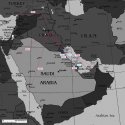 USAF forces by location:
USAF forces by location:
Incirlik, Turkey - 22 F-111E, 24 F-15C, 37 F-16C
Al Taif, Saudi Arabia - 66 F-111F
Tabuk, Saudi Arabia (n. Jeddah) - 24 F-15C
Al Kharj, Saudi Arabia (n. Riyadh) - 48 F-15E, 24 F-15C, 40 F-16A
Dharham, Saudi Arabia (n. Dammam) - 48 F-15C
King Fahd, Saudi Arabia (n. Dammam)- 144 A-10C
Al Dhafra, UAE (n. Abu Dhabi) - 72 F-16C
Al Minnad, UAE (n. Dubai) - 72 F-16C
Shaik Isa, Bahrain - 48 F-4G
Doha, Qatar - 24 F-16C
USN forces in the Persian Gulf: Midway (CV-41), Independence (CV-42), Saratoga (CV-60). Ranger (CV-61), America (CV-66), Kennedy (CV-67), Eisenhower (CVN-69), Roosevelt (CVN-71)
Aerial refueling operations (Gulf War Air Survey)
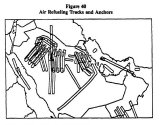
The data from the Survey (see previous post) indicates that regular air-to-ground missions - typically classified as "air interdiction" - did
not constitute the largest share of aerial refueling operations .
The largest share of aerial refueling came from long-duration patrols - E-3s, B-52s (from Guam and Diego Garcia), F-15C and F-14As. F-16s despite having largest number of sorties (~14k) took less than half of the fuel (89m lbs.) that F-15Cs took with 12k sorties. (198m lbs.) The standard air-to-air loadout of a F-15C was 4 AIM-7Ms and 3 external tanks and despite that they took 12k lbs per refueling event. It must have been caused by the duration of patrol and the altitude which was kept high for the purposes of giving the fighters energy advantage.
The F-16 has a very short combat radius of ~700km clean and ~500km with moderate loadout. To be able to operate from bases in UAE where 144 F-16s were stationed they would have to carry 3 tanks and perform one refueling on the way back. Even then they would not be able to go much further than the area immediately beyond Kuwait's border.
Now, for comparison see the indicative distances to Taipei and Kao-Hsiung from select bases in Eastern and Southern theaters.
[1280x1280px]
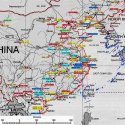
I don't think airbases on the immediate coast would be ideal for the beginning of Taiwan operation. There is simply too much risk involved so the initial airstrikes would have to be performed from greater distances. This brings them closer in line with ODS distances and does nothing to resolve the question of air superiority and AEW patrols remaining in the air for prolonged periods of time out of tactical necessity.
I think while it is incorrect to directly extrapolate from ODS data the operation remains a very good primer for understanding the issues of planning, logistics and effectiveness - and that's why I post the data. You are not supposed to treat ODS as a set of ready answers but as a useful and informative guide to finding approximate solutions to the hypothetical Taiwan operation.
But what about the ballistic and cruise missiles the PLA has and how that lessens the need for air sorties?
If you look at the data on munitions in Desert Storm you'll see that 297 Tomahawks and 35 conventional ALCMs were launched. Additionally 50-60 ATACMS short-range ballistic missiles were launched by US Army. The overall number of missiles is close to 400 and it still required the entire air campaign with cited FS/NFS ratios and tons and tons of bombs.
A missile is essentially a disposable attack aircraft. There's nothing special about it compared to a bomb other than conditions of delivery. In actual war numbers matter and while missiles are useful for planning of operations they can't replace payload on target over time. The enemy is working to fix the damage as fast as you can deal it.
I don't think PLA would waste missiles on anything except the absolutely necessary targets. They're simply too expensive to be used against Taiwan considering that the operation might result in a longer conflict including limited armed conflict with the US - especially if PLA doesn't conserve best munitions as deterrent. Those missiles might be better used against e.g. USMC outposts on Taiwan.
There is another factor that you forgot to consider - missiles are not resources which are as easily and quickly moved between locations as aircraft. Rocket units have their designated areas of operation and designated roles in those areas so they could only be massed temporarily. As you can imagine temporarily massing ground units for the purpose of strike against Taiwan is significantly harder than temporarily massing aircraft - especially if aerial refueling assets are available in sufficient number. If ground-based long-range air defenses of Taiwan are disabled - even temporarily - then H-6 fleet is sufficient to perform a massed strike with stand-off weapons that would be more effective than missiles. Driving all those trucks until they are in range? That's not a good idea for achieving surprise.
And apparently precision-guided munitions were 35x more likely to hit their targets during Desert Storm
A similar claim is contradicted by the findings in GAO report. The effectiveness of PGMs was greatly exaggerated by both USAF and the manufacturers and data is clear on that. It's all in the tables I posted earlier.
PGMs are great for the kind of warfare that followed after Gulf War - when minimizing collateral damage, exposure of own forces, and operational cost is essential to continuing the wars of aggression. Gulf War was very expensive. Iraq War in 2003 was achieved with fewer resources, not to mention the rest of GWOT operations. Those would be impossible without PGMs but they were not in the same category as even the Gulf War, the "parade war" as PLA's analysts called it.
The evolution of technology - most notably increasing ranges of anti-air missiles and sensors - will require stand-off weapons and greater use of PGMs but it won't be an order of magnitude reduction. I would expect a third of munitions used in ODS-equivalent, maybe a quarter, but not fewer because the accuracy of those weapons can also be affected by counter-measures. Restrikes will happen if only to ensure that the target remains neutralized just like they happened in ODS.
Finally the sheer number of potential targets will force the PGMs to be economical and that means PGMs that are as effective as unguided munitions in ODS due to distances of deployment. They won't be top of the line because numbers matter. At this point PLA guidance technology is matched by enemy's counter-measure technology. It's not the same kind of disparity as US and Iraq in 1991 and likely won't be for the next 10-20 years.
A few words about the numbers on the ground.
The number of identified targets (Gulf War Air Power Survey)
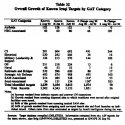 The middle column "known 16 Jan 91" is relevant for Desert Storm aerial operations. It shows the total number of targets which should be correlated with the data on effectiveness of strikes from GAO report if you are interested how many attempts were necessary.
Deployment of Iraqi ground forces
The middle column "known 16 Jan 91" is relevant for Desert Storm aerial operations. It shows the total number of targets which should be correlated with the data on effectiveness of strikes from GAO report if you are interested how many attempts were necessary.
Deployment of Iraqi ground forces (ibid.)
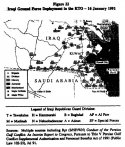
Compare this with the number of Fully Successful / Not Fully Successful sorties and the data on restrikes.
That's a lot of weapons that once expended can't be replaced quickly enough for another operation - like a hypothetical US involvement.
One of the most misunderstood lessons from recent conflicts is that while air combat evolves very rapidly and the number of casualties in air-to-air drops precipitously since the 70s - and a lot of that has to do with introduction of ARH BVR missiles - the effectiveness of airstrikes on ground targets, especially armored or reinforced positions remains the same as in WW2 which is
very low.
USAF did not achieve the efficiency it claimed in Desert Storm and it did not achieve the efficiency in Serbia. Air power has decisive role in affecting enemy's decision-making and initiative but not combat capability. It can limit enemy logistics but can't break prepared defenses. For that ground operation is necessary and because ground operations take more time any preceding or simultaneous air operation would have to bring sufficient resources to suppress enemy defenses. That means even more weapons which means even more PGMs which means cheaper and simpler PGMs so that they can be used when needed and in sufficient quantities.
Let's not forget - 30+ years of USAF PR might have confused ordinary people but it couldn't have confused professional planners. Air power does not win wars. Never did. Never will. And if you don't believe me - ask the Taliban. Air power is the enabler, not the solution. No matter what the pilots might think of themselves it's all about the humble grunt on the ground.





